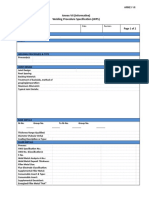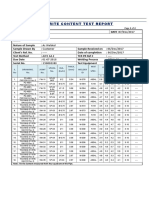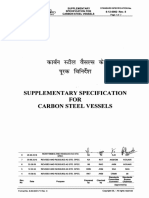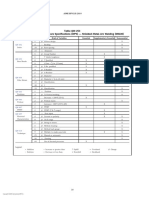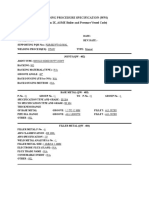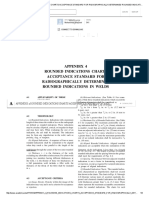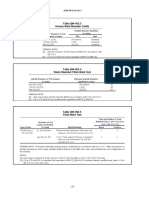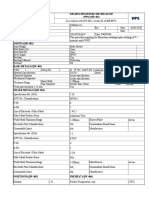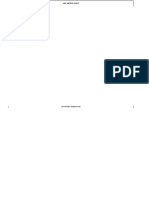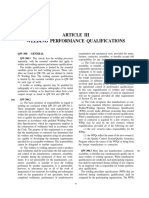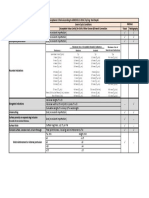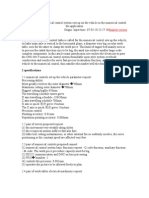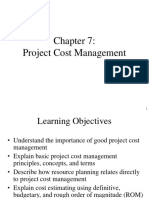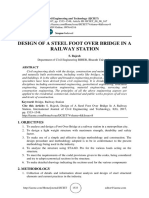Table 341.3.2 Acceptance Criteria For Welds - Visual and Radiographic Examination
Table 341.3.2 Acceptance Criteria For Welds - Visual and Radiographic Examination
Uploaded by
erboalCopyright:
Available Formats
Table 341.3.2 Acceptance Criteria For Welds - Visual and Radiographic Examination
Table 341.3.2 Acceptance Criteria For Welds - Visual and Radiographic Examination
Uploaded by
erboalOriginal Description:
Original Title
Copyright
Available Formats
Share this document
Did you find this document useful?
Is this content inappropriate?
Copyright:
Available Formats
Table 341.3.2 Acceptance Criteria For Welds - Visual and Radiographic Examination
Table 341.3.2 Acceptance Criteria For Welds - Visual and Radiographic Examination
Uploaded by
erboalCopyright:
Available Formats
ð18Þ Table 341.3.
2 Acceptance Criteria for Welds — Visual and Radiographic Examination
Criteria (A to M) for Types of Welds and for Service Conditions [Note (1)]
Normal and Category M Fluid
Service Severe Cyclic Conditions Category D Fluid Service Examination Methods
Girth, Girth,
Miter Miter
Groove, and Groove, and Girth
Branch Longitudinal Branch and Branch
Connection Groove Fillet Connection Longitudinal Fillet Miter Longitudinal Fillet Connection
Welds Weld Weld Welds Groove Weld Weld Groove Groove Weld Weld Weld
[Note (2)] [Note (3)] [Note (4)] [Note (2)] [Note (3)] [Note (4)] Welds [Note (3)] [Note (4)] [Note (2)] Weld Imperfection Visual Radiography
A A A A A A A A A A Crack ✓ ✓
A A A A A A C A N/A A Lack of fusion ✓ ✓
B A N/A A A N/A C A N/A B Incomplete penetration ✓ ✓
E E N/A D D N/A N/A N/A N/A N/A Rounded Indications … ✓
G G N/A F F N/A N/A N/A N/A N/A Linear indications … ✓
H A H A A A I A H H Undercutting ✓ ✓
A A A A A A A A A A Surface porosity or exposed slag ✓ …
inclusion [Note (5)]
ASME B31.3-2018
N/A N/A N/A J J J N/A N/A N/A N/A Surface finish ✓ …
K K N/A K K N/A K K N/A K Concave surface, concave root, or ✓ ✓
burn-through
84
L L L L L L M M M M Weld reinforcement or internal ✓ …
protrusion
GENERAL NOTES:
(a) Weld imperfections are evaluated by one or more of the types of examination methods given, as specified in paras. 341.4.1, 341.4.2, 341.4.3, and M341.4, or by the engineering design.
(b) “N/A” indicates the Code does not establish acceptance criteria or does not require evaluation of this kind of imperfection for this type of weld.
(c) Check (✓) indicates examination method generally used for evaluating this kind of weld imperfection.
(d) Ellipsis (…) indicates examination method not generally used for evaluating this kind of weld imperfection.
NOTES:
(1) Criteria given are for required examination. More-stringent criteria may be specified in the engineering design. See also paras. 341.5 and 341.5.3.
(2) Branch connection weld includes pressure containing welds in branches and fabricated laps.
(3) Longitudinal groove weld includes straight and spiral (helical) seam. Criteria are not intended to apply to welds made in accordance with a standard listed in Table A-1, Table A-1M, or
Table 326.1. Alternative Leak Test requires examination of these welds; see para. 345.9.
(4) Fillet weld includes socket and seal welds, and attachment welds for slip-on flanges, branch reinforcement, and supports.
(5) These imperfections are evaluated only for welds ≤5 mm (3∕16 in.) in nominal thickness.
ð18Þ Criterion Value Notes for Table 341.3.2
Criterion
Symbol Measure Acceptable Value Limits [Note (1)]
A Extent of imperfection Zero (no evident imperfection)
B Cumulative length of incomplete penetration ≤38 mm (1.5 in.) in any 150 mm (6 in.) weld length
or 25% of total weld length, whichever is less
C Cumulative length of lack of fusion and incomplete ≤38 mm (1.5 in.) in any 150 mm (6 in.) weld length
penetration or 25% of total weld length, whichever is less
D Size and distribution of rounded indications See ASME BPVC, Section VIII, Division 1, Appendix 4 [Note (2)]
E Size and distribution of rounded indications For Tw 6 mm (1∕4 in.), limit is same as D [Note (2)]
For Tw > 6 mm (1∕4 in.), limit is 1.5 × D [Note (2)]
F Linear indications
Individual length Tw/3
Individual width ≤2.5 mm (3∕32 in.) and Tw/3
Cumulative length Tw in any 12 Tw weld length [Note (2)]
G Linear indications
Individual length 2Tw
ASME B31.3-2018
Individual width ≤3 mm (1∕8 in.) and Tw/2
Cumulative length 4Tw in any 150 mm (6 in.) weld length [Note (2)]
85
H Depth of undercut ≤1 mm (1∕32 in.) and Tw/4
Cumulative length of internal and external undercut ≤38 mm (1.5 in.) in any 150 mm (6 in.) weld length
or 25% of total weld length, whichever is less
I Depth of undercut ≤1.5 mm (1∕16 in.) and [Tw/4 or 1 mm (1∕32 in.)]
Cumulative length of internal and external undercut ≤38 mm (1.5 in.) in any 150 mm (6 in.) weld length
or 25% of total weld length, whichever is less
J Surface roughness ≤12.5 μm (500 μin.) Ra in accordance with ASME B46.1
K Depth of surface concavity, root concavity, or Total joint thickness, including weld reinforcement, Tw [Notes (3) and (4)]
burn-through
L Height of reinforcement or internal protrusion [Note (5)] in For Tw, mm (in.) Height, mm (in.)
any plane through the weld shall be within limits of 1
≤6 ( ∕4) ≤1.5 (1∕16)
the applicable height value in the tabulation at right,
1 1
except as provided in Note (6). Weld metal shall merge >6 ( ∕4), ≤13 ( ∕2) ≤3 (1∕8)
1
smoothly into the component surfaces. >13 ( ∕2), ≤25 (1) ≤4 (5∕32)
>25 (1) ≤5 (3∕16)
M Height of reinforcement or internal protrusion [Note (5)] Limit is twice the value applicable for L above
as described in L. Note (6) does not apply.
NOTES:
(1) Where two limiting values are separated by “and,” the lesser of the values determines acceptance. Where two sets of values are separated by “or,” the larger value is acceptable. Tw is the nominal
wall thickness of the thinner of two components joined by a butt weld.
Criterion Value Notes for Table 341.3.2 (Cont’d)
NOTES: (Cont’d)
(2) Porosity and inclusions such as slag or tungsten are defined as rounded indications where the maximum length is three times the width or less. These indications may be circular, elliptical, or
irregular in shape; may have tails; and may vary in density. Indications where the length is greater than three times the width are defined as linear indications and may also be slag, porosity, or
tungsten.
(3) For circumferential groove welded joints in pipe, tube, and headers made entirely without the addition of filler metal, external concavity shall not exceed the lesser of 1 mm (1∕32 in.) or 10% of the
joint nominal thickness. The contour of the concavity shall blend smoothly with the base metal. The total joint thickness, including any reinforcement, shall not be less than the minimum wall
thickness, tm.
(4) For radiography, acceptability may be determined by comparing the density of the image through the affected area to the density through the adjacent base metal ( Tw). If digital radiography is
used, brightness comparison may be utilized. A density or brightness darker than the adjacent base metal is cause for rejection.
(5) For groove welds, height is the lesser of the measurements made from the surfaces of the adjacent components; both reinforcement and internal protrusion are permitted in a weld. For fillet
welds, height is measured from the theoretical throat, Figure 328.5.2A; internal protrusion does not apply.
(6) For welds in aluminum alloy only, internal protrusion shall not exceed the following values:
(a) 1.5 mm (1∕16 in.) for thickness ≤2 mm (5∕64 in.)
(b) 2.5 mm (3∕32 in.) for thickness >2 mm and ≤6 mm (1∕4 in.)
For external reinforcement and for greater thicknesses, see the tabulation for symbol L.
ASME B31.3-2018
86
You might also like
- Errata 1: Welding of Pipelines and Related Facilities, 22Document7 pagesErrata 1: Welding of Pipelines and Related Facilities, 22Peter MangalukiNo ratings yet
- 1410D 0475-xxx ENG Ver1Document304 pages1410D 0475-xxx ENG Ver1massoniparts100% (5)
- RT Acceptance Criteria All CodeDocument1 pageRT Acceptance Criteria All Codemukhlis mirghani100% (1)
- API 1104 Acceptance CriteriaDocument1 pageAPI 1104 Acceptance CriteriaMekhman100% (1)
- RT Acceptance Criteria B31.3 2020, Api 1104 (2021), IX 2021Document6 pagesRT Acceptance Criteria B31.3 2020, Api 1104 (2021), IX 2021Kader KaderNo ratings yet
- ASME B31.3 - 2014 - Table 341.3.2 - AcceptanceDocument4 pagesASME B31.3 - 2014 - Table 341.3.2 - AcceptanceDjamel100% (6)
- Carbon Steel: Wps No. Rev. P.No Material PQR Thickness Process PWHT Preheat SR # Filler MaterialDocument6 pagesCarbon Steel: Wps No. Rev. P.No Material PQR Thickness Process PWHT Preheat SR # Filler Materialvipin100% (1)
- Welding Procedure Specification (WPS) FormDocument2 pagesWelding Procedure Specification (WPS) FormEarl Harbert0% (2)
- Ferrite Content ReportDocument2 pagesFerrite Content ReportJawad MunirNo ratings yet
- RT Acceptance Criteria 10062019Document1 pageRT Acceptance Criteria 10062019Balkishan Dyavanapelly100% (2)
- Impact Test RequiredDocument1 pageImpact Test RequiredZouhair BenmabroukNo ratings yet
- SP 2016 - 3016 - 4016 Operators Manual Spemfi13 (Awea)Document278 pagesSP 2016 - 3016 - 4016 Operators Manual Spemfi13 (Awea)Nageshagowda Nageshagowda100% (1)
- Approved Structural Steel-Welding Procedures - Double V-Groove With Back Gouge PDFDocument3 pagesApproved Structural Steel-Welding Procedures - Double V-Groove With Back Gouge PDFBhavani PrasadNo ratings yet
- Critére D'acceptation PT API 650 ASME VIIIDocument4 pagesCritére D'acceptation PT API 650 ASME VIIITahar DabbarNo ratings yet
- P91 ProfileDocument6 pagesP91 ProfilesrinivasanNo ratings yet
- Weld Repair After PWHT ASME Sec VIII Div.1Document6 pagesWeld Repair After PWHT ASME Sec VIII Div.1GesNo ratings yet
- 1.radiograph AcceptanceDocument1 page1.radiograph AcceptanceTURNO100% (2)
- 6-12-0002 Rev 8 Supplementary Specification For Carbon Steel VesselsDocument7 pages6-12-0002 Rev 8 Supplementary Specification For Carbon Steel Vesselsravi2007No ratings yet
- Dimension Check & Fit Up Inspection Report (Piping)Document1 pageDimension Check & Fit Up Inspection Report (Piping)ZaidiNo ratings yet
- Table QW-253 Welding Variables Procedure Specifications (WPS) - Shielded Metal-Arc Welding (SMAW)Document2 pagesTable QW-253 Welding Variables Procedure Specifications (WPS) - Shielded Metal-Arc Welding (SMAW)BabarNo ratings yet
- Acceptance Criteria of Weld Defects As Per Different CodesDocument17 pagesAcceptance Criteria of Weld Defects As Per Different CodesShankar Pl GowdaNo ratings yet
- (Section IX, ASME Boiler and Pressure Vessel Code) : Welding Procedure Specification (WPS)Document2 pages(Section IX, ASME Boiler and Pressure Vessel Code) : Welding Procedure Specification (WPS)Quality LaveenaNo ratings yet
- Specification Requirement For CRA & CRA Clad PipelineDocument2 pagesSpecification Requirement For CRA & CRA Clad PipelineSơn Nguyễn Thái100% (1)
- 328.4.2 End Preparation: ASME B31.3-2012Document2 pages328.4.2 End Preparation: ASME B31.3-2012Stephen Raj100% (1)
- Wps & Pqr-013 (Ss Gtaw-Smaw TGS)Document17 pagesWps & Pqr-013 (Ss Gtaw-Smaw TGS)Atuk SafizNo ratings yet
- Appendix 4 Rounded Indications Charts Acceptance Standard For Radiographically Determined Rounded Indications in WeldsDocument8 pagesAppendix 4 Rounded Indications Charts Acceptance Standard For Radiographically Determined Rounded Indications in WeldsStephen RajNo ratings yet
- Proposed To Revision To QW-423.1: QW-423 Alternate Base Materials For Welder Qualification QW-423.1Document4 pagesProposed To Revision To QW-423.1: QW-423 Alternate Base Materials For Welder Qualification QW-423.1Marcio Jr.No ratings yet
- Section II A SA-435 - SA-435MDocument3 pagesSection II A SA-435 - SA-435MSocrates MoralesNo ratings yet
- Zzze) I (ZFRP: QW-163 Acceptance Criteria - Bend Tests QW-163 Acceptance Criteria - Bend TestsDocument1 pageZzze) I (ZFRP: QW-163 Acceptance Criteria - Bend Tests QW-163 Acceptance Criteria - Bend TestsSARSAN NDTNo ratings yet
- WPS - 006Document13 pagesWPS - 006MAT-LIONNo ratings yet
- PQR - PipeDocument3 pagesPQR - PipeAdvanced Quality Centre AQC100% (1)
- Welder Diameter Limitation ASME SEC IXDocument1 pageWelder Diameter Limitation ASME SEC IXkumarNo ratings yet
- Shell Rolling Report 1Document6 pagesShell Rolling Report 1Hanuman RaoNo ratings yet
- Kerosene Leak TestDocument4 pagesKerosene Leak Testskc50% (2)
- WPS 05Document4 pagesWPS 05Naqqash SajidNo ratings yet
- PART 66 ASME IX - Part 2 Essential Variable For Welder QualificationDocument13 pagesPART 66 ASME IX - Part 2 Essential Variable For Welder Qualificationravindra_jivani100% (1)
- RT Acceptance Criteria For Welder Test According To ASME Sec IX (QW 191 1.2)Document20 pagesRT Acceptance Criteria For Welder Test According To ASME Sec IX (QW 191 1.2)Oscar Iván Duque Diaz100% (1)
- PEIPL-WI-01Electrode BakingDocument2 pagesPEIPL-WI-01Electrode BakingBalkishan Dyavanapelly100% (1)
- Asme Section 1 - Pmi PDFDocument3 pagesAsme Section 1 - Pmi PDFArul Edwin Vijay100% (1)
- Line History SheetDocument46 pagesLine History SheetBhanu Pratap Choudhury50% (4)
- Asme b31.3 Acceptance RT TabulatedDocument86 pagesAsme b31.3 Acceptance RT TabulatedWalter Trajada100% (2)
- Sfa-5.01 Filler Metal Procurement GuidelinesDocument10 pagesSfa-5.01 Filler Metal Procurement GuidelinesCesar Agustin LimousinNo ratings yet
- Strip Check - EIL - TQ PDFDocument2 pagesStrip Check - EIL - TQ PDFpl_arunachalam79No ratings yet
- Wps Aws d1.1 NEWDocument2 pagesWps Aws d1.1 NEWIkhy Tohepaly100% (2)
- WPS For SSDocument1 pageWPS For SSdeepakNo ratings yet
- Pressure Vessel Dimension InspectionDocument10 pagesPressure Vessel Dimension InspectionYetkin ErdoğanNo ratings yet
- QW-451 Procedure Qualification Thickness Limits and Test SpecimensDocument2 pagesQW-451 Procedure Qualification Thickness Limits and Test Specimensmitesh0% (1)
- Fracture TestDocument1 pageFracture TestYuvaraj SathishNo ratings yet
- ASME SEC IX Article Iii, Welding Performance QualificationsDocument11 pagesASME SEC IX Article Iii, Welding Performance QualificationsTeoxNo ratings yet
- Welding Procedure Specification: WPS For SS Material 304 (GTAW+SMAW)Document1 pageWelding Procedure Specification: WPS For SS Material 304 (GTAW+SMAW)Lipika GayenNo ratings yet
- Electrode Brad Qualification Procedure As Per ASME Section II Part C Along With NPCIL ProcedureDocument2 pagesElectrode Brad Qualification Procedure As Per ASME Section II Part C Along With NPCIL ProcedurePrashant Puri100% (2)
- Acceptance Craiteria of API1104, ASME B31.3 and AWS D.1.1Document7 pagesAcceptance Craiteria of API1104, ASME B31.3 and AWS D.1.1MJ Magdy100% (1)
- TABLA ASME - B31.3 - Ed.2018 (001-269) (114-117)Document4 pagesTABLA ASME - B31.3 - Ed.2018 (001-269) (114-117)ANDRES LOPEZNo ratings yet
- ASME 31.3 - 2016 VT, UtDocument2 pagesASME 31.3 - 2016 VT, UtsanketNo ratings yet
- Acceptance Criteria Asme B31.3 PDFDocument1 pageAcceptance Criteria Asme B31.3 PDFAhmad RizkiNo ratings yet
- Acceptance Criteria Asme B31.3 PDFDocument1 pageAcceptance Criteria Asme B31.3 PDFAhmad Rizki100% (1)
- Extracted Pages From ASME B31.3-2022Document1 pageExtracted Pages From ASME B31.3-2022H_DEBIANENo ratings yet
- Marco GDocument3 pagesMarco GMAEBNo ratings yet
- GD&T WikipediaDocument4 pagesGD&T WikipediaJayesh PatilNo ratings yet
- Welding Symbol Reference ChartDocument2 pagesWelding Symbol Reference ChartAamer MohammedNo ratings yet
- Acceptable Std. For NDTDocument4 pagesAcceptable Std. For NDTHarshaVeeragandhamNo ratings yet
- The CNC h4 SystemDocument8 pagesThe CNC h4 SystemRobert GiangNo ratings yet
- QUANTITATIVE CHEMISTRY Corrected FinalDocument32 pagesQUANTITATIVE CHEMISTRY Corrected FinalJinNo ratings yet
- Department of Mechanical Engineering Centralized Internal Exam - IiDocument2 pagesDepartment of Mechanical Engineering Centralized Internal Exam - IiRajesh ChidambaramNo ratings yet
- Karnataka Science and Technology Promotion Society (Ksteps) : DST Scholarship For Ph.D. in Science and EngineeringDocument3 pagesKarnataka Science and Technology Promotion Society (Ksteps) : DST Scholarship For Ph.D. in Science and EngineeringASHIK BELLARYNo ratings yet
- HwcompatDocument460 pagesHwcompatValldiney CruzNo ratings yet
- HPs PDFDocument54 pagesHPs PDFacesrspNo ratings yet
- MOP IndiaDocument219 pagesMOP Indiaempty87No ratings yet
- Theories of FailureDocument62 pagesTheories of FailureAjith MosesNo ratings yet
- Lecture 11Document39 pagesLecture 11B RAMUNo ratings yet
- Project Cost ManagementDocument33 pagesProject Cost ManagementwossenNo ratings yet
- 1-Avaya Contact Recorder Release 12.0 Planning, Installation and Adminis PDFDocument398 pages1-Avaya Contact Recorder Release 12.0 Planning, Installation and Adminis PDFMiguel VillegasNo ratings yet
- 10 Question PT QuizDocument3 pages10 Question PT Quizsafeer ahmadNo ratings yet
- Glare Matters: What Is Glare, When Is It Harmful, and How To Control ItDocument50 pagesGlare Matters: What Is Glare, When Is It Harmful, and How To Control Itsasithar jaisankaranNo ratings yet
- Grundfosliterature 146158Document16 pagesGrundfosliterature 146158AddeNifiraNo ratings yet
- Velomitor® Piezo-Velocity Sensor: DescriptionDocument6 pagesVelomitor® Piezo-Velocity Sensor: DescriptionDwi Mulyanti DwimulyantishopNo ratings yet
- CMG Cap 1000Document40 pagesCMG Cap 1000savio77No ratings yet
- Design of Railway Footover Bridge by IJCDocument16 pagesDesign of Railway Footover Bridge by IJCRamesh KaradiNo ratings yet
- 0.6. TR-18 Stockbridge Type Vibration DampersDocument10 pages0.6. TR-18 Stockbridge Type Vibration Dampersgiorgis072No ratings yet
- Aspen Flare System AnalyzerDocument1 pageAspen Flare System AnalyzerMiftah MasrurNo ratings yet
- 7 FiltrationDocument25 pages7 FiltrationJonelou CusipagNo ratings yet
- Class 8 Science Worksheet - Combustion and Flame Part BDocument2 pagesClass 8 Science Worksheet - Combustion and Flame Part BVipul Vaibhav MahajanNo ratings yet
- Chryso DP Bonding Agent - 8940 - 5655Document2 pagesChryso DP Bonding Agent - 8940 - 5655Knowledge SeekerNo ratings yet
- Triton-Powered Saw TableDocument32 pagesTriton-Powered Saw Tableauger88No ratings yet
- IEEE Guide For Calculation of Fault Currents For Application of AC High-Voltage Circuit Breakers Rated On A Total Current BasisDocument4 pagesIEEE Guide For Calculation of Fault Currents For Application of AC High-Voltage Circuit Breakers Rated On A Total Current BasisRichard Ninasunta GuanoquizaNo ratings yet
- Carpet Floorring-Method StatementDocument6 pagesCarpet Floorring-Method StatementMuhib sadeddeinNo ratings yet
- Ebon Hawk Instructions by Martinux-D32hfs2Document91 pagesEbon Hawk Instructions by Martinux-D32hfs2Matheus ValinNo ratings yet
- Engineering PDFDocument107 pagesEngineering PDFYuvaraj YucatanNo ratings yet
- 110cc Four Stroke ATV User Manual: Prepared By: Adventure Imports New Zealand WWW - Adventureimports.co - NZDocument17 pages110cc Four Stroke ATV User Manual: Prepared By: Adventure Imports New Zealand WWW - Adventureimports.co - NZradu tiberiuNo ratings yet







